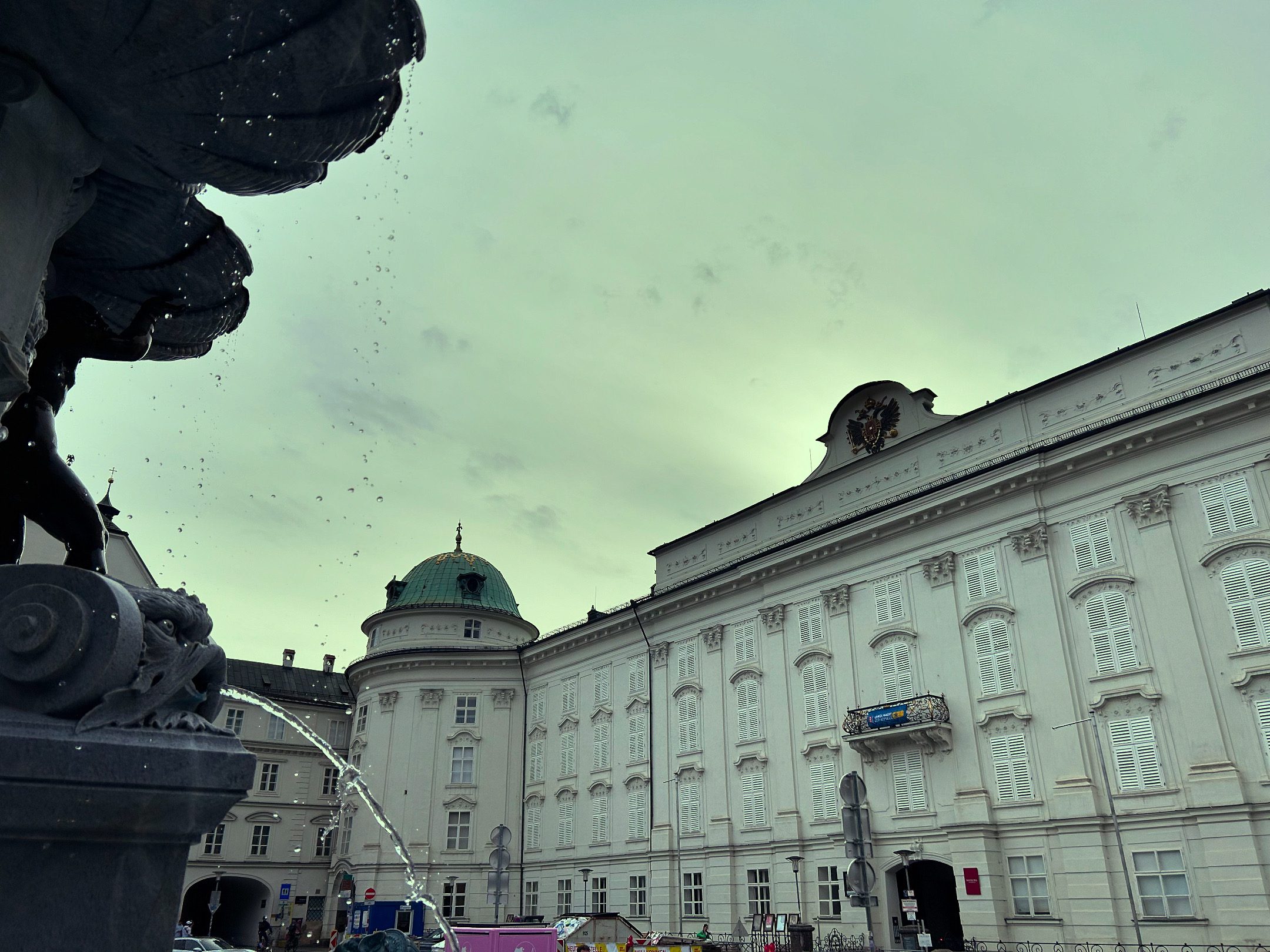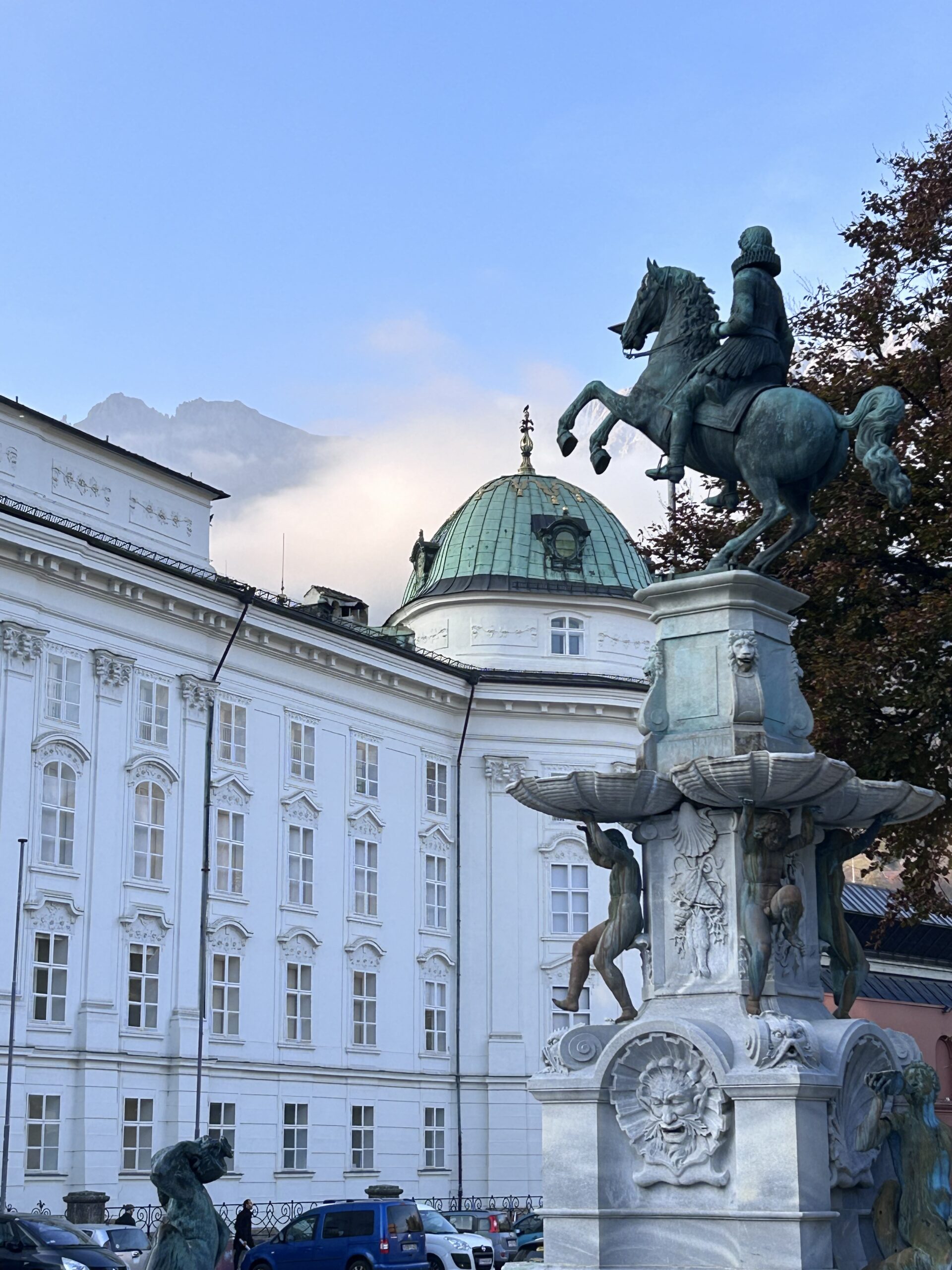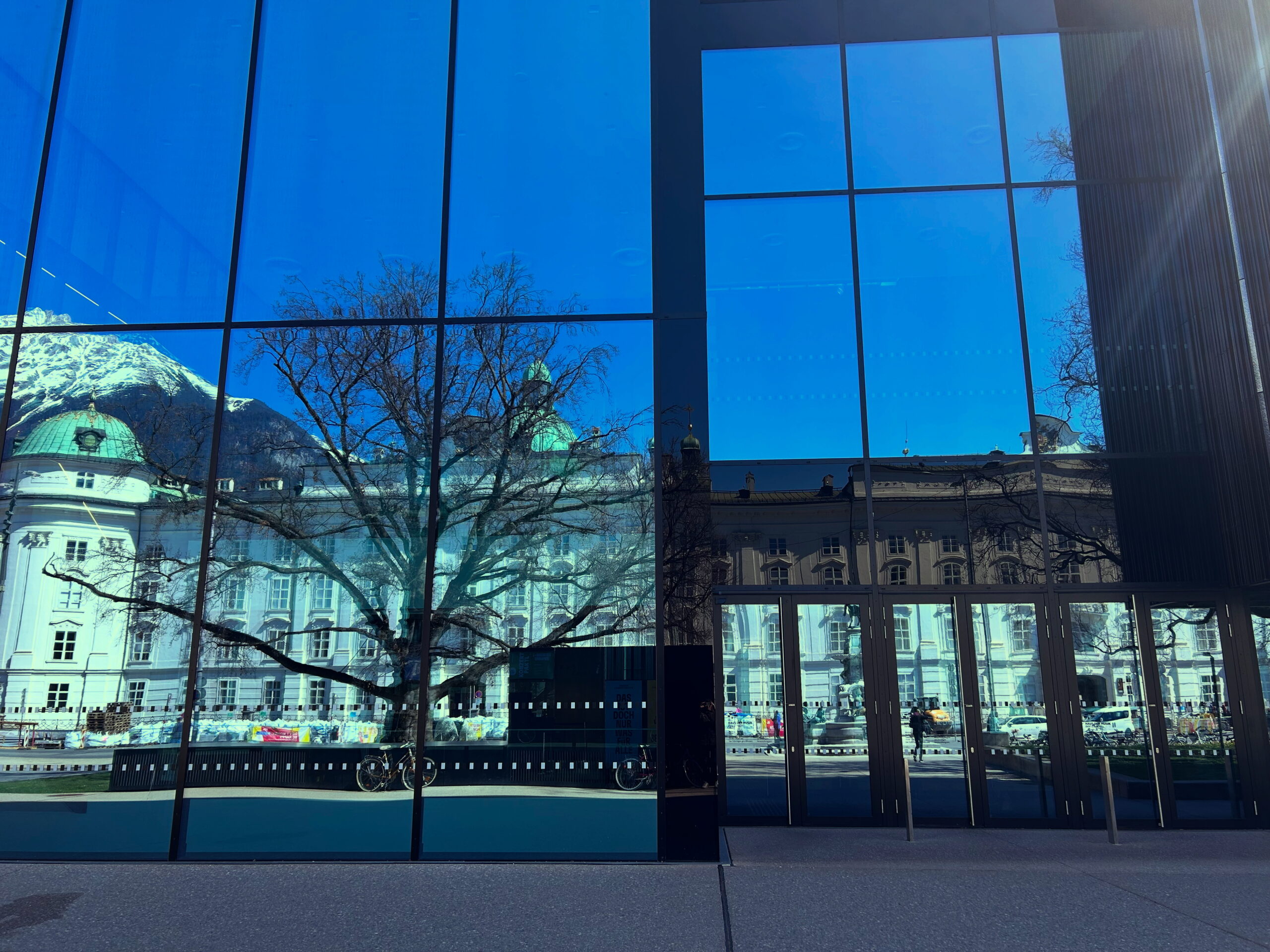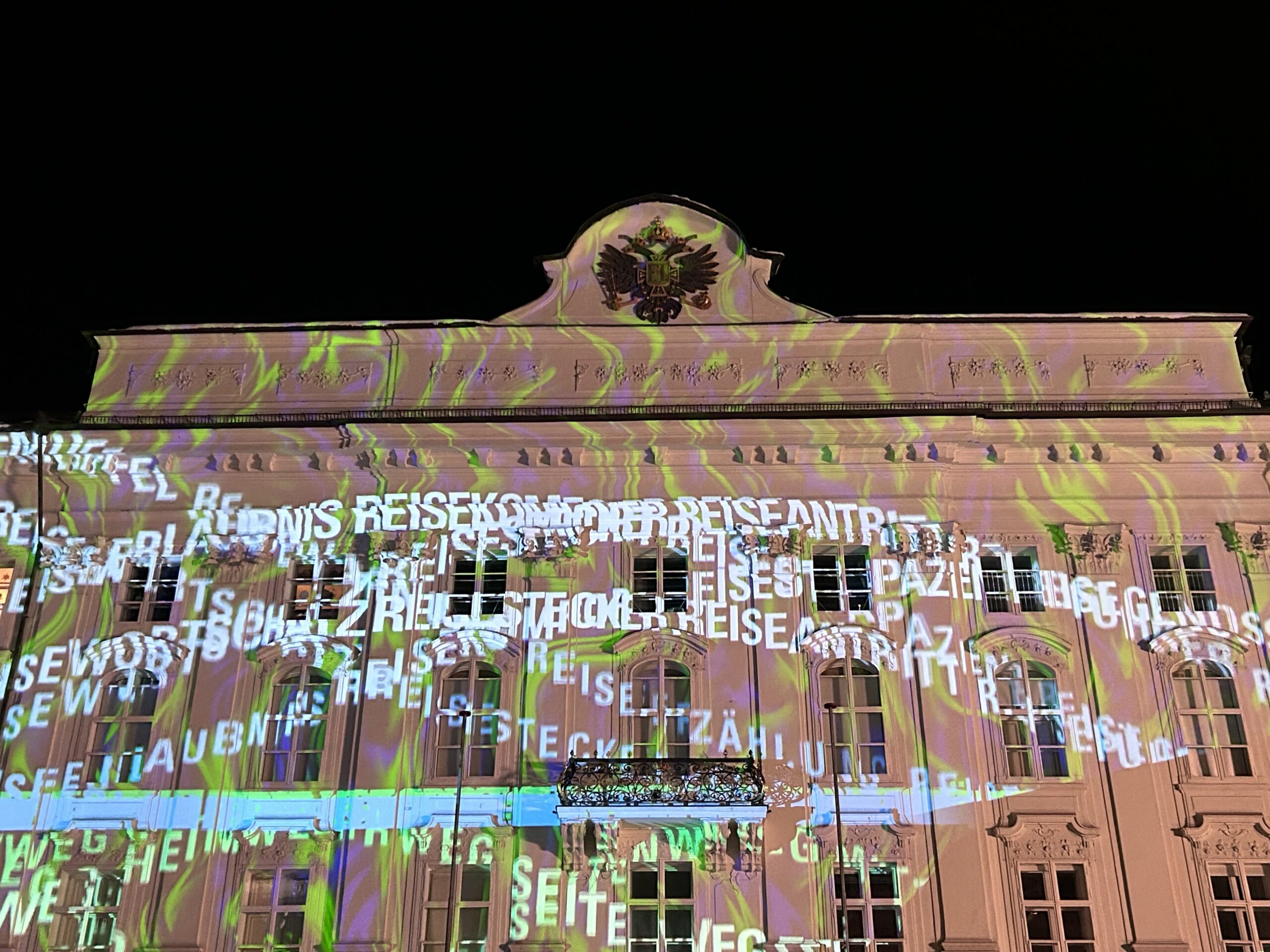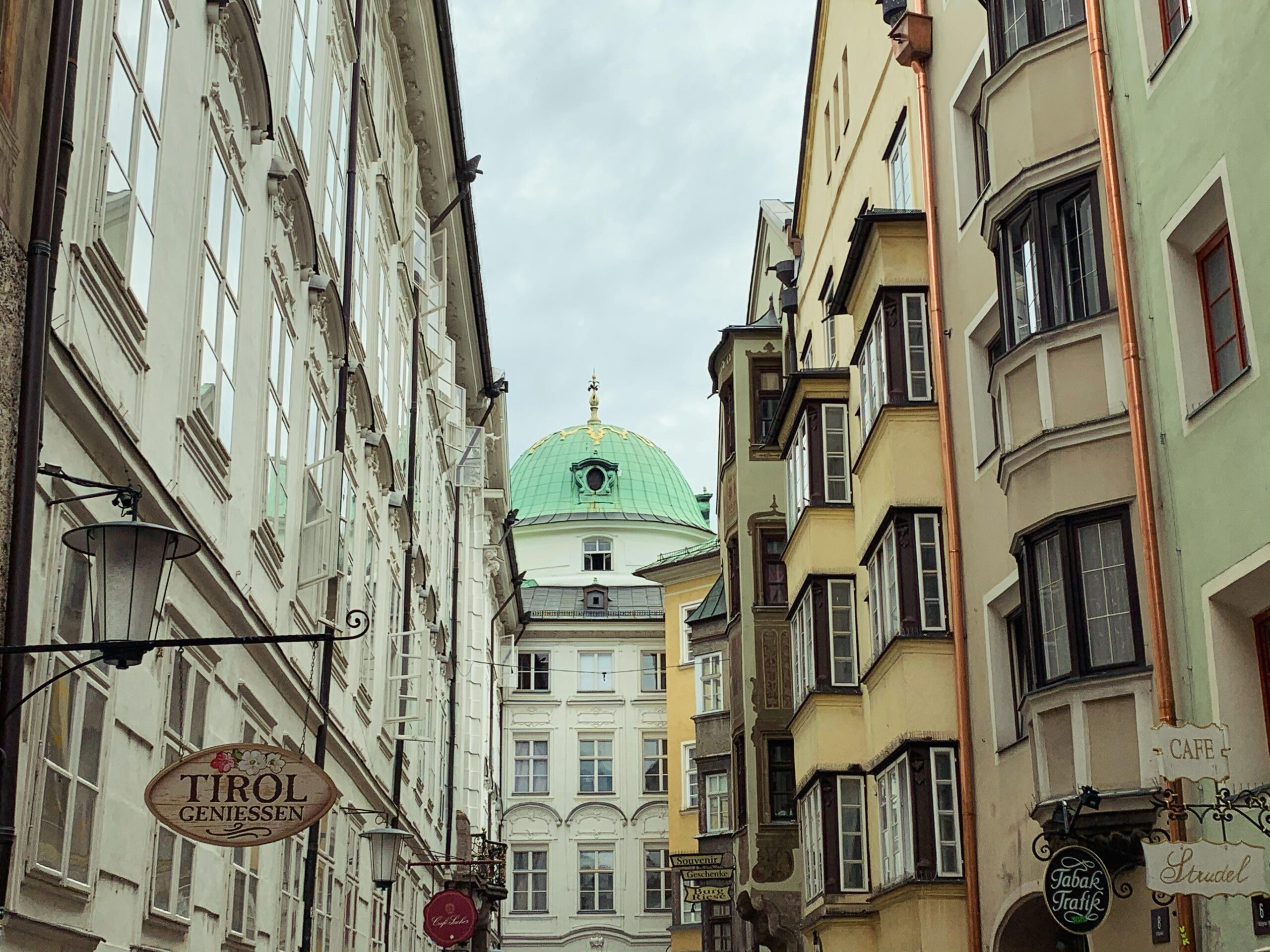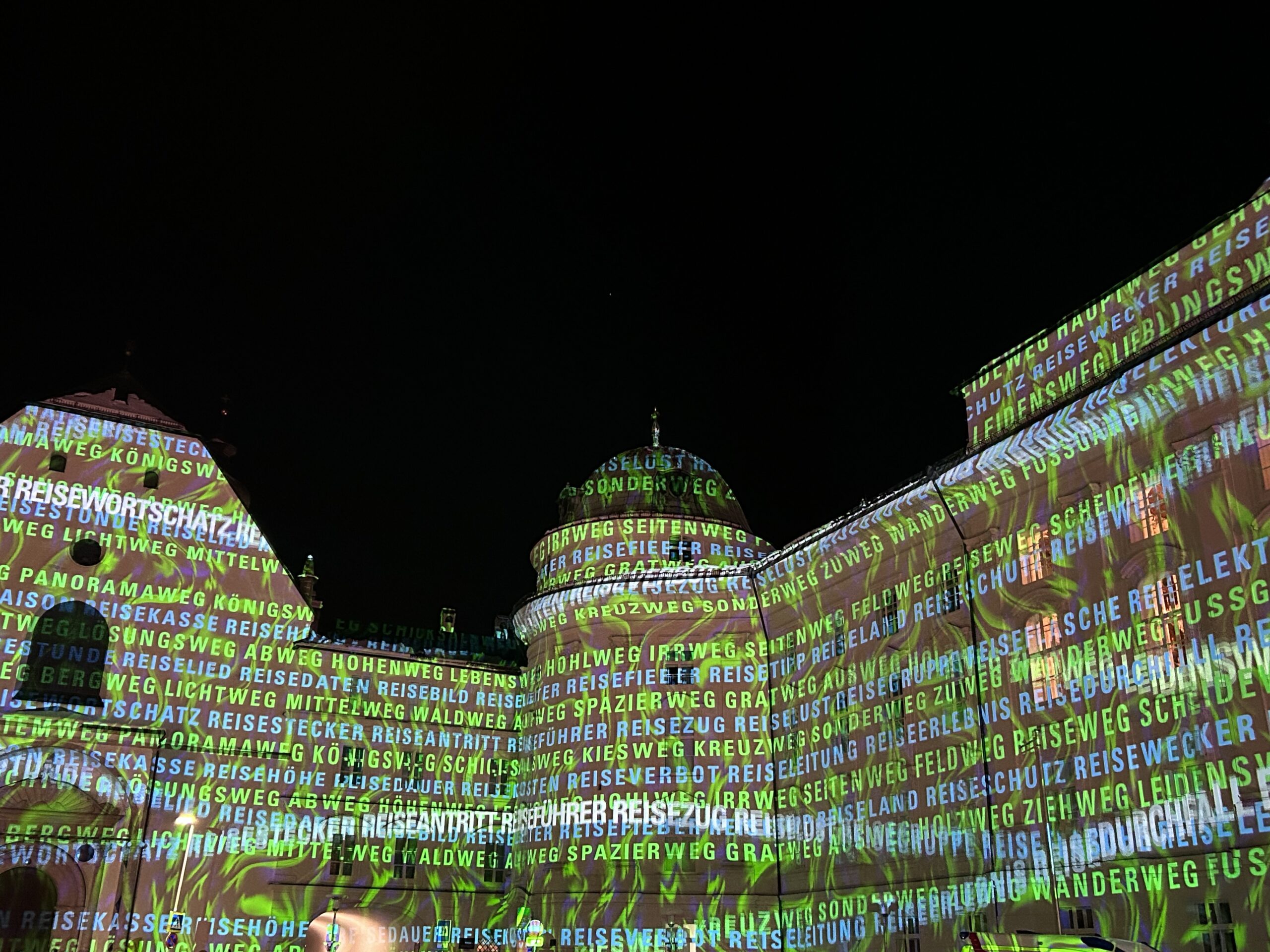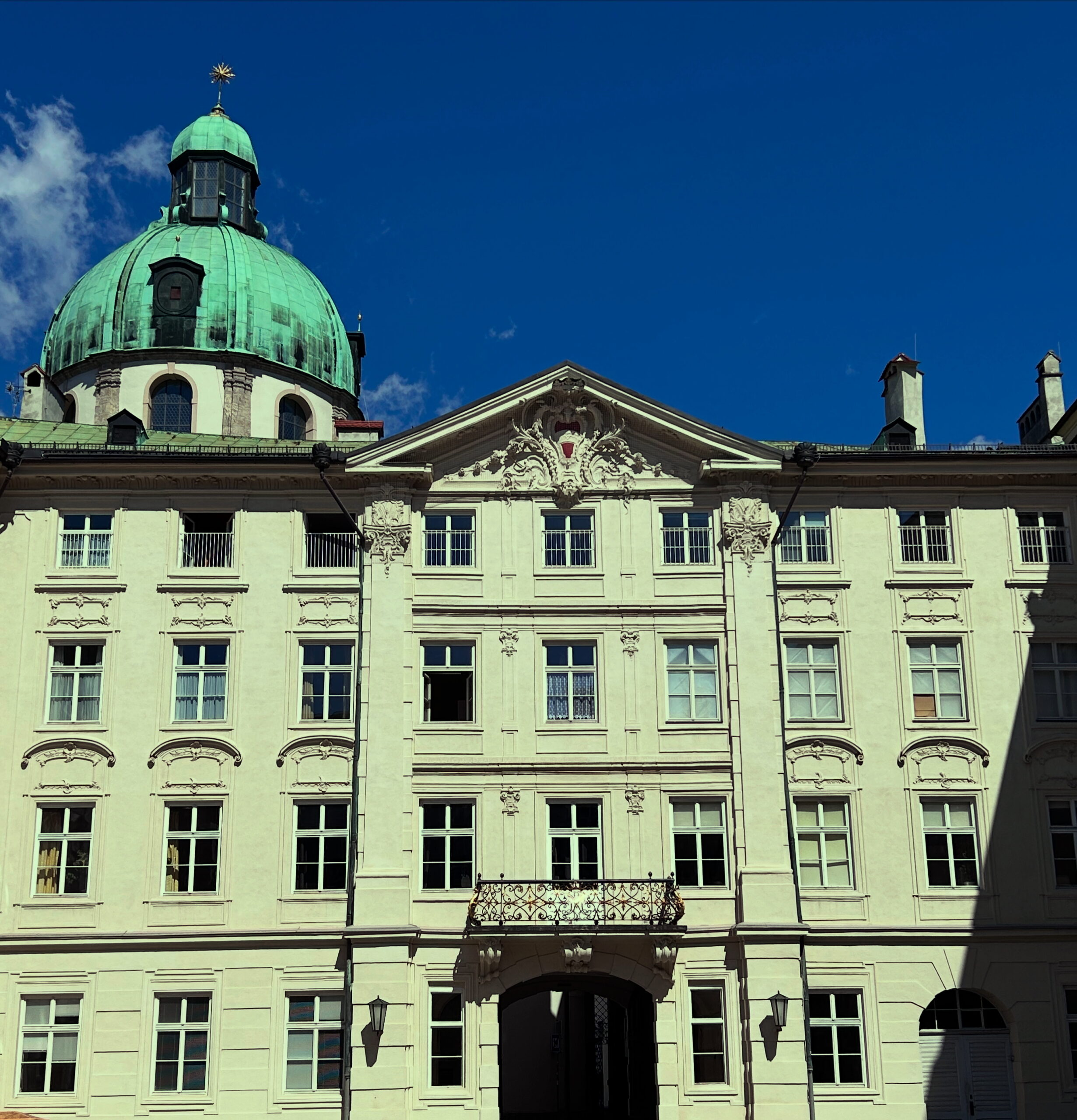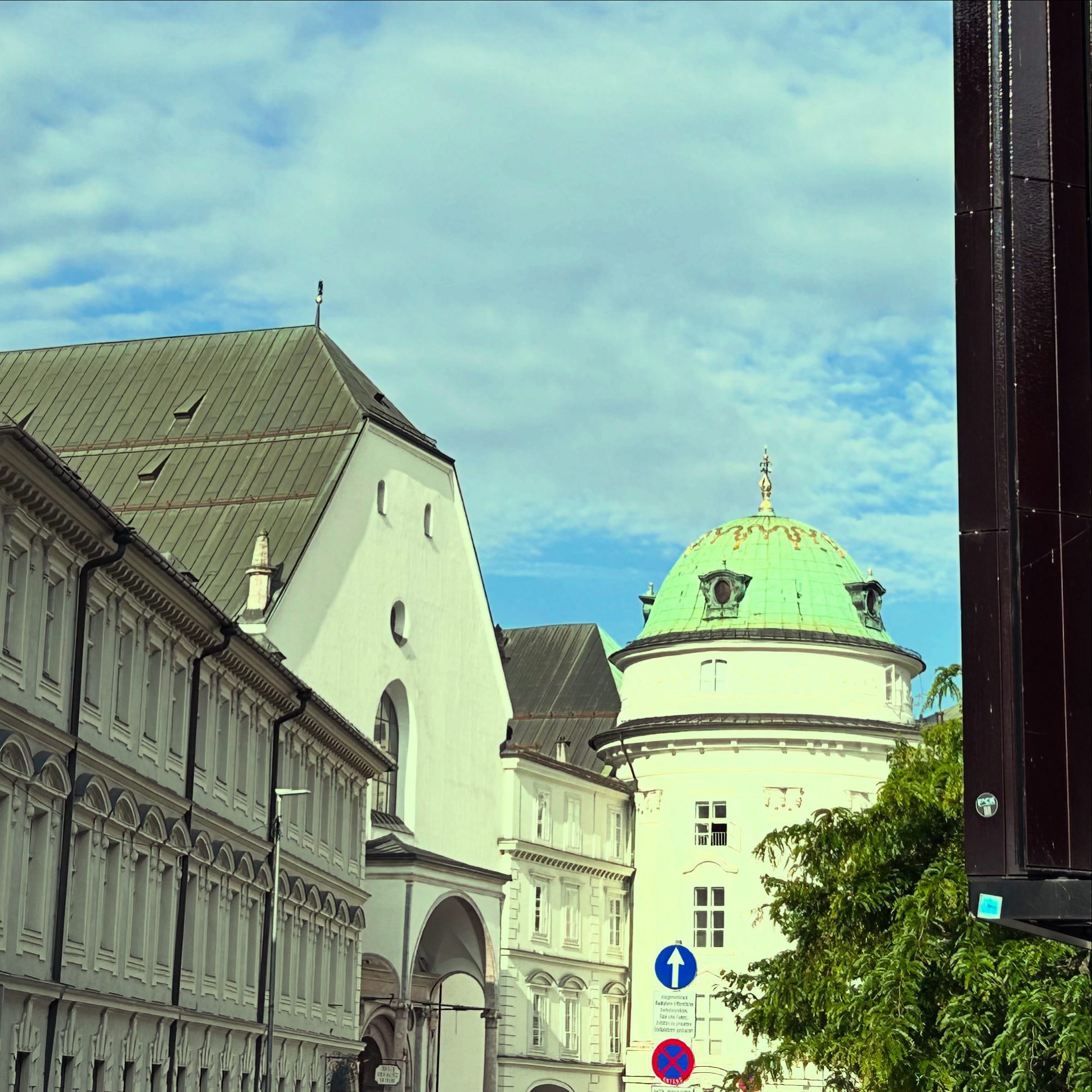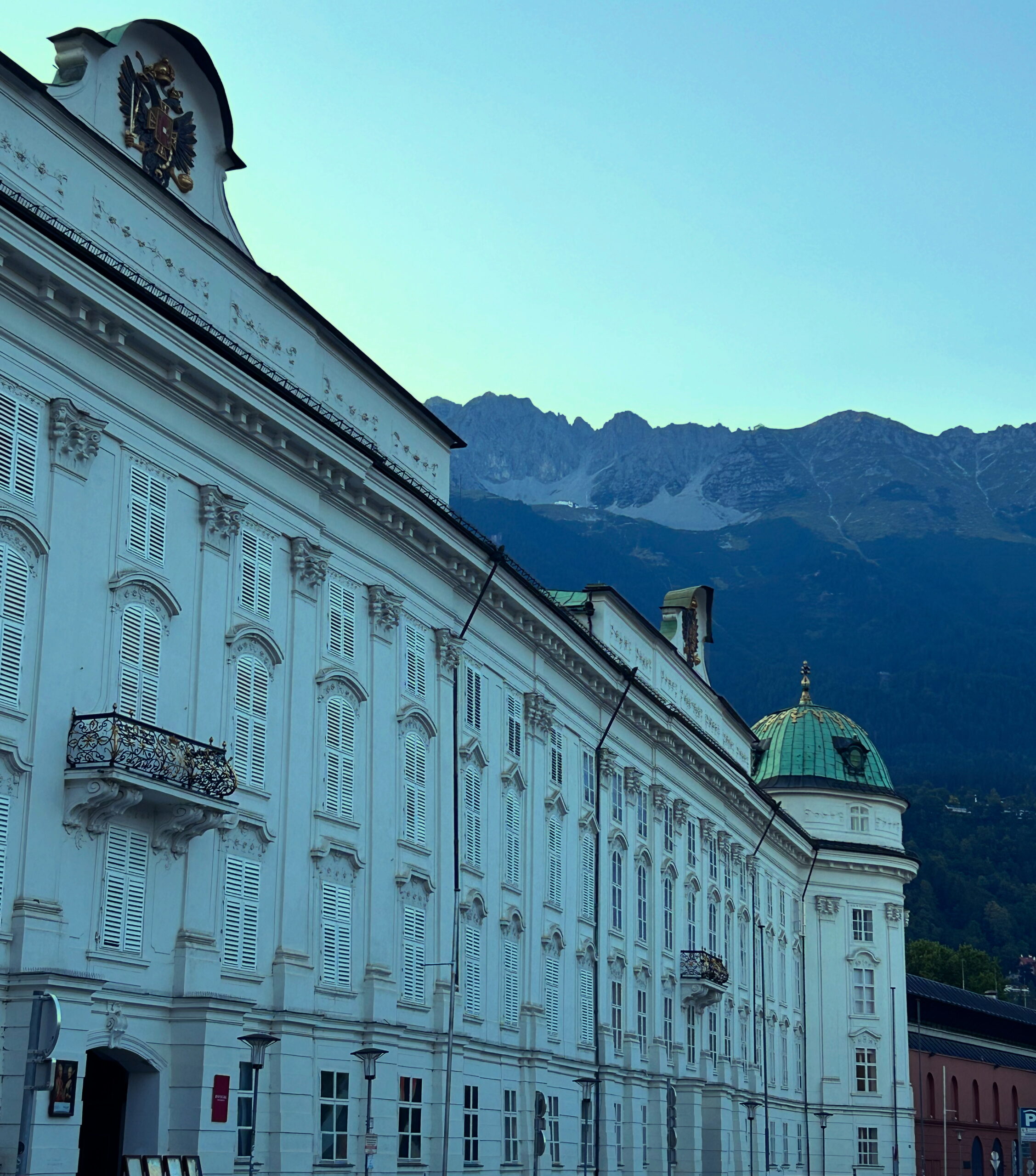Hofburg
Rennweg 1
Worth knowing
Alongside the Vienna Hofburg and Schönbrunn Palace, the Hofburg in Innsbruck is Austria's third imperial palace complex. The history of Innsbruck's Hofburg is like a walk through the past centuries of Innsbruck and is one of the city's most important sights. On the east side, the imperial double-headed eagle is emblazoned on the gleaming white baroque façade. The Hofburg has always been a symbol of Habsburg rule.
The Tyrolean prince Leopold IV acquired the property south of the parish church at the end of the 14th century. When Frederick IV moved the seat of Tyrol's government from Merano to Innsbruck, he resided in the Neuhof, today's Goldenem Dachl. Erst sein Sohn Siegmund „der Münzreiche" had a castle built at this location on the outer wall of the city on the site of today's Hofburg, adjacent to the Sagg Gate, which still existed at the time. The complex was not so much part of the courtly representation, it was part of the defences of the growing city.
Emperor Maximilian I moved his residence from the Neuhof, which had become too small, to the Hofburg around 1490. In the following years, he had the complex extended to its current size of 5000 square metres. The cemetery of the parish church of St James in the old town had to make way for this. In 1497, the Habsburg treasury was moved to the Hofburg. Innsbruck had become an important financial centre of the Holy Roman Empire. Under Maximilian, both the court administration and the number of visitors to Innsbruck grew. Innsbruck had been elevated to one of the residence cities within the Habsburg Empire. Contrary to popular belief, the emperor himself was rarely present, but Maximilian's second wife Bianca Maria Sforza spent a lot of time in Innsbruck. Both the functionality and size of the court infrastructure had to be adapted to the First Lady. A watercolour by Albrecht Dürer shows a Gothic ensemble of half-timbered houses grouped around an inner courtyard. The chambers, the so-called „Frauenzimmer“ were built at this time. Tournaments were held in front of the castle, on today's Rennweg, to provide entertainment for the members of the court. Maximilian's grandson, Emperor Ferdinand I, also used Innsbruck as a temporary residence for himself and his family. Under his son Ferdinand II, the Hofburg and thus also Innsbruck became one of the most important centres of 16th century Renaissance court culture north of the Alps, even if the sovereign himself preferred to spend his time at Ambras Castle.
The Innsbruck Hofburg owes its current rococo-style appearance to Austria's most prominent regent, Maria Theresa. Although she was only present twice herself, the old Gothic walls were anathema to her. The new architecture was designed by the architects Johann Martin Gumpp the Younger and Nicolaus von Pacassi. After 1754, the Gothic castle was remodelled into a modern, representative Baroque palace. The defence towers at the corners were turned into ornate roundels. The Gothic cellar at the north end has been preserved and is now used as an atmospheric event hall. The inner courtyard is well worth a visit early in the morning or in the evening when the Hofburg employees' cars are no longer parked there. Maria Theresa also founded the Innsbruck Ladies' Convent on the south side of the Innsbruck Hofburg. Her husband Emperor Franz Stephan had died in Innsbruck. 16 noble ladies were to pray for the salvation of the emperor's soul in his death chamber, which was converted into a convent. Maria Theresa, who was regarded as the regent of the Enlightenment, was also still aware that life after death was more important than life on earth. Maria Elisabeth, one of her daughters, took over the management of the monastery, who was popularly known as the kropferte Liesl was baptised. In the 19th century, the governor of Tyrol, Archduke Karl Ludwig, had the interior furnished and renovated with rococo furniture by August La Vigne for his sister-in-law Elisabeth. The wife of Franz Joseph I was a guest in Innsbruck on several occasions, while her sister resided in the nearby Mentlberg Palace.
In 1918, the Habsburg monarchy came to an end and the Hofburg became the property of the Republic of German-Austria. It is administered by the specially founded Burghauptmannschaft. Part of the Hofburg can be visited. The highlights are the halls of Empress Maria Theresa and the Empress Elisabeth flat of Sissi as well as the Riesensaal with pictures of Maria Theresa's family. A room was also dedicated to Andreas Hofer. The Tyrolean rebel resided in the Hofburg for around two months in 1809. A picture of Franz Defregger, which was taken over 70 years later for a magazine, shows the Tyrolean captain in Tyrolean leather trousers receiving an imperial delegation in the ceremonial hall of the residence of the Tyrolean sovereigns. The ladies' convent still exists today. Prayers for the salvation of Emperor Franz Stephan's soul are probably still being said diligently.
Maria Theresia, Reformatorin und Landesmutter
Maria Theresia zählt zu den bedeutendsten Figuren der österreichischen Geschichte. Obwohl sie oft als Kaiserin tituliert wird, war sie offiziell "nur" unter anderem Erzherzogin von Österreich, Königin von Ungarn und Königin von Böhmen. Bedeutend waren ihre innenpolitischen Reformen. Viele davon betrafen konkret auch den Alltag der Innsbrucker in merklichem Ausmaß. Gemeinsam mit ihren Beratern Friedrich Wilhelm von Haugwitz, Joseph von Sonnenfels und Wenzel Anton Kaunitz schaffte sie es aus den sogenannten Österreichischen Erblanden einen modernen Staat zu basteln. Anstatt der Verwaltung ihrer Territorien durch den ansässigen Adel setzte sie auf eine moderne Verwaltung. Ihre Berater hatten ganz im Stil der Aufklärung erkannt, dass sich das Staatswohl aus der Gesundheit und Bildungsgrad seiner Einzelteile ergab. Eine frühe Krankenreform Maria Theresias aus dem Jahr 1742 verpflichtete die Professoren des Fachbereichs Medizin an der Universität Innsbruck auch den Betrieb des Stadtspitals in der Neustadt sicherzustellen. Eine Schulreform veränderte die Bildungslandschaft innerhalb der Stadtmauern nicht nur thematisch, sondern auch örtlich. Untertanen sollten katholisch sein, ihre Treue aber sollte dem Staat gelten. Schulbildung wurde unter zentrale staatliche Verwaltung gestellt. Es sollten keine kritischen, humanistischen Geistesgrößen, sondern Material für den staatlichen Verwaltungsapparat erzogen werden. Über Militär und Verwaltung konnten nun auch Nichtadlige in höhere staatliche Positionen aufsteigen. Gleichzeitig sollten Reformen im Staatsdienst und in der Wirtschaft nicht nur mehr Möglichkeiten für die Untertanen schaffen, sondern auch die Staatseinnahmen erhöhen. Gewichte und Maßeinheiten wurden nominiert, um das Steuersystem undurchlässiger zu machen. Für Bürger und Bauern hatte die Vereinheitlichung der Gesetze den Vorteil, dass das Leben weniger von Grundherren und deren Launen abhing. Auch der Robot, den Bauern auf den Gütern des Grundherrn kostenfrei zu leisten hatten, wurde unter Maria Theresia abgeschafft. In Strafverfolgung und Justiz fand ein Umdenken statt. 1747 wurde in Innsbruck eine kleine Polizei which was responsible for matters relating to market supervision, trade regulations, tourist control and public decency. The penal code Constitutio Criminalis Theresiana did not abolish torture, but it did regulate its use.
As much as Maria Theresa staged herself as a pious mother of the country and is known today as an Enlightenment figure, the strict Catholic ruler was not squeamish when it came to questions of power and religion. In keeping with the trend of the Enlightenment, she had superstitions such as vampirism, which was widespread in the eastern parts of her empire, critically analysed and initiated the final end to witch trials. At the same time, however, she mercilessly expelled Protestants from the country. Many Tyroleans were forced to leave their homeland and settle in parts of the Habsburg Empire further away from the centre.
In crown lands such as Tyrol, Maria Theresa's reforms met with little favour. With the exception of a few liberals, they saw themselves more as an independent and autonomous province and less as part of a modern territorial state. The clergy also did not like the new, subordinate role, which became even more pronounced under Joseph II. For the local nobility, the reforms not only meant a loss of importance and autonomy, but also higher taxes and duties. Taxes, levies and customs duties, which had always provided the city of Innsbruck with reliable income, were now collected centrally and only partially refunded via financial equalisation. In order to minimise the fall of sons from impoverished aristocratic families and train them for civil service, Maria Theresa founded the Theresianum, das ab 1775 auch in Innsbruck eine Niederlassung hatte. Wie so oft bügelte die Zeit manche Falte aus und Innsbrucker sind mittlerweile stolz darauf, eine der bedeutendsten Herrscherpersönlichkeiten der österreichischen Geschichte beherbergt zu haben. Heute erinnern die Triumphpfote und die Hofburg in Innsbruck an die Theresianische Zeit.
Baroque: art movement and art of living
Anyone travelling in Austria will be familiar with the domes and onion domes of churches in villages and towns. This form of church tower originated during the Counter-Reformation and is a typical feature of the Baroque architectural style. They are also predominant in Innsbruck's cityscape. Innsbruck's most famous places of worship, such as the cathedral, St John's Church and the Jesuit Church, are in the Baroque style. Places of worship were meant to be magnificent and splendid, a symbol of the victory of true faith. Religiousness was reflected in art and culture: grand drama, pathos, suffering, splendour and glory combined to create the Baroque style, which had a lasting impact on the entire Catholic-oriented sphere of influence of the Habsburgs and their allies between Spain and Hungary.
The cityscape of Innsbruck changed enormously. The Gumpps and Johann Georg Fischer as master builders as well as Franz Altmutter's paintings have had a lasting impact on Innsbruck to this day. The Old Country House in the historic city centre, the New Country House in Maria-Theresien-Straße, the countless palazzi, paintings, figures - the Baroque was the style-defining element of the House of Habsburg in the 17th and 18th centuries and became an integral part of everyday life. The bourgeoisie did not want to be inferior to the nobles and princes and had their private houses built in the Baroque style. Pictures of saints, depictions of the Mother of God and the heart of Jesus adorned farmhouses.
Baroque was not just an architectural style, it was an attitude to life that began after the end of the Thirty Years' War. The Turkish threat from the east, which culminated in the two sieges of Vienna, determined the foreign policy of the empire, while the Reformation dominated domestic politics. Baroque culture was a central element of Catholicism and its political representation in public, the counter-model to Calvin's and Luther's brittle and austere approach to life. Holidays with a Christian background were introduced to brighten up people's everyday lives. Architecture, music and painting were rich, opulent and lavish. In theatres such as the Comedihaus dramas with a religious background were performed in Innsbruck. Stations of the cross with chapels and depictions of the crucified Jesus dotted the landscape. Popular piety in the form of pilgrimages and the veneration of the Virgin Mary and saints found its way into everyday church life. Multiple crises characterised people's everyday lives. In addition to war and famine, the plague broke out particularly frequently in the 17th century. The Baroque piety was also used to educate the subjects. Even though the sale of indulgences was no longer a common practice in the Catholic Church after the 16th century, there was still a lively concept of heaven and hell. Through a virtuous life, i.e. a life in accordance with Catholic values and good behaviour as a subject towards the divine order, one could come a big step closer to paradise. The so-called Christian edification literature was popular among the population after the school reformation of the 18th century and showed how life should be lived. The suffering of the crucified Christ for humanity was seen as a symbol of the hardship of the subjects on earth within the feudal system. People used votive images to ask for help in difficult times or to thank the Mother of God for dangers and illnesses they had overcome.
The historian Ernst Hanisch described the Baroque and the influence it had on the Austrian way of life as follows:
„Österreich entstand in seiner modernen Form als Kreuzzugsimperialismus gegen die Türken und im Inneren gegen die Reformatoren. Das brachte Bürokratie und Militär, im Äußeren aber Multiethnien. Staat und Kirche probierten den intimen Lebensbereich der Bürger zu kontrollieren. Jeder musste sich durch den Beichtstuhl reformieren, die Sexualität wurde eingeschränkt, die normengerechte Sexualität wurden erzwungen. Menschen wurden systematisch zum Heucheln angeleitet.“
The rituals and submissive behaviour towards the authorities left their mark on everyday culture, which still distinguishes Catholic countries such as Austria and Italy from Protestant regions such as Germany, England or Scandinavia. The Austrians' passion for academic titles has its origins in the Baroque hierarchies. The expression Baroque prince describes a particularly patriarchal and patronising politician who knows how to charm his audience with grand gestures. While political objectivity is valued in Germany, the style of Austrian politicians is theatrical, in keeping with the Austrian bon mot of "Schaumamal".
The master builders Gumpp and the baroqueisation of Innsbruck
The works of the Gumpp family still strongly characterise the appearance of Innsbruck today. The baroque parts of the city in particular can be traced back to them. The founder of the dynasty in Tyrol, Christoph Gumpp (1600-1672), was actually a carpenter. However, his talent had chosen him for higher honours. The profession of architect or artist did not yet exist at that time; even Michelangelo and Leonardo da Vinci were considered craftsmen. After working on the Holy Trinity Church, the Swabian-born Gumpp followed in the footsteps of the Italian master builders who had set the tone under Ferdinand II. At the behest of Leopold V, Gumpp travelled to Italy to study theatre buildings and to learn from his contemporary style-setting colleagues his expertise for the planned royal palace. Comedihaus polish up.
His official work as court architect began in 1633. New times called for a new design, away from the Gothic-influenced architecture of the Middle Ages and the horrors of the Thirty Years' War. Over the following decades, Innsbruck underwent a complete renovation under the regency of Claudia de Medici. Gumpp passed on his title to the next two generations within the family. The Gumpps were not only active as master builders. They were also carpenters, painters, engravers and architects, which allowed them to create a wide range of works similar to the Tiroler Moderne around Franz Baumann and Clemens Holzmeister at the beginning of the 20th century to realise projects holistically. They were also involved as planners in the construction of the fortifications for national defence during the Thirty Years' War.
Christoph Gumpp's masterpiece, however, was the construction of the Comedihaus in the former ballroom. The oversized dimensions of the then trend-setting theatre, which was one of the first of its kind in Europe, not only allowed plays to be performed, but also water games with real ships and elaborate horse ballet performances. The Comedihaus was a total work of art in and of itself, which in its significance at the time can be compared to the festival theatre in Bayreuth in the 19th century or the Elbphilharmonie today.
His descendants Johann Martin Gumpp the Elder, Georg Anton Gumpp and Johann Martin Gumpp the Younger were responsible for many of the buildings that still characterise the townscape today. The Wilten collegiate church, the Mariahilfkirche, the Johanneskirche and the Spitalskirche were all designed by the Gumpps. In addition to designing churches and their work as court architects, they also made a name for themselves as planners of secular buildings. Many of Innsbruck's town houses and city palaces, such as the Taxispalais or the Altes Landhaus in Maria-Theresien-Straße, were designed by them. With the loss of the city's status as a royal seat, the magnificent large-scale commissions declined and with them the fame of the Gumpp family. Their former home is now home to the Munding confectionery in the historic city centre. In the Pradl district, Gumppstraße commemorates the Innsbruck dynasty of master builders.
Maximilian I. und seine Zeit
Maximilian is one of the most important personalities in European and Innsbruck city history. He is said to have said about Tyrol: "Tirol ist ein grober Bauernkittel, der aber gut wärmt." Perhaps it was not only Innsbruck's location in the middle of the mountains that was a reason for his affection, Maximilian was a keen hunter. His father Friedrich III was born in Innsbruck in 1415. It certainly paid off for the city. During his reign, Maximilian turned Innsbruck into one of the most important centres of the Holy Roman Empire, changing its fortunes for good. "Wer immer sich im Leben kein Gedächtnis macht, der hat nach seinem Tod kein Gedächtnis und derselbe Mensch wird mit dem Glockenton vergessen.“ Maximilian actively and successfully countered this fear by erecting highly visible symbols of imperial power such as the Goldenen Dachl against. Propaganda, images and the media played an increasingly important role, partly due to the burgeoning printing press. Maximilian used art and culture to maintain his presence. For example, he kept an imperial choir, a music band that was mainly used for public appearances and receptions of international envoys. He had a veritable cult of personality organised around himself with coins, books, printed matter and paintings.
For all the romanticism that this lover of courtly traditions and chivalry cultivated, he was a cool-headed power politician. Under him, political institutions such as the Imperial Diet, the Imperial Court of Justice and the Imperial Chamber Court were established, which strictly regulated the relationship between subjects, sovereign and monarchy. Around 1500, Tyrol had around 300,000 inhabitants. More than 80% of the people worked in agriculture and lived for the most part from the yields of the farms. In a veritable furore of new laws, Maximilian curtailed the peasants' rights to the commons. Logging, hunting and fishing were placed under the control of the sovereign and were no longer common property. This had a negative impact on peasant self-sufficiency. Thanks to the new laws, hunters became poachers. Meat and fish had long been part of the diet in the Middle Ages, but now this indulgence became a luxury that could often only be obtained illegally. Maximilian was therefore unpopular with a large part of the population during his lifetime.
Restrictions on self-sufficiency were joined by new taxes. It had always been customary for sovereigns to impose additional taxes on the population in the event of war. Maximilian's warfare differed from medieval conflicts. The auxiliary troops and their noble, chivalrous landlords were supplemented or completely replaced by mercenaries who knew how to use modern firearms.
Diese neue Art ins Feld zu ziehen, verschlang Unsummen. Als die Erträge aus den landesfürstlichen Besitzungen wie Münz-, Markt-, Bergwerks-, und Zollregal nicht mehr ausreichten, wurden die einzelnen Bevölkerungsgruppen je nach Stand und Vermögen besteuert, jedoch war die Steuer noch weit entfernt von unserem heutigen ausdifferenzierten System und brachten dementsprechend Ungerechtigkeit und Unmut mit sich. Ein Beispiel für eine Abgabe war Maximilians Common penny. The wealth tax amounted to between 0.1 and 0.5% of wealth, but was capped at 1 guilder. Jews had to pay a poll tax of 1 guilder regardless of their wealth. For the first time, princes were also asked to pay, but due to the cap, they paid a maximum of the same amount as a middle-class Jew. Prelates, priests and secular lords were responsible for announcing and enforcing the tax. Pastors had to announce the tax from the pulpit on three Sundays, collect the contributions together with representatives of the courts and enter them in the Imperial Tax Register.
It was quickly realised that this type of tax collection did not work. A modern system and tax model was needed. A collegial chamber, the Regiment, centrally supervised the provinces of Tyrol and Vorderösterreich according to the modern model of Burgundian finance, which Maximilian had learnt about during his time in the Netherlands. Innsbruck became the financial and accounting centre for the Austrian lands. The Rait chamber and the House chamber were located in the Neuhof, where today the Goldene Dachl über die Altstadt residiert. 1496 wurden die finanziellen Mittel der österreichischen Erbländer in der Schatzkammer in Innsbruck gebündelt. Vorsitzender der Hofkammer war der Brixner Bischof Melchior von Meckau, der mehr und mehr die Fugger als Kreditgeber miteinbezog. Beamten wie Jakob Villinger (1480 - 1529) wickelten in der italienisch geprägten Form der doppelten Buchhaltung den Geldverkehr mit Bankhäusern aus ganz Europa ab und probierten den kaiserlichen Finanzhaushalt in Zaum zu halten. Talentierte Kleinadelige und Bürger, studierte Juristen und ausgebildete Beamten lösten den Hochadel in bestimmender Funktion ab. Finanzexperten aus Burgund hatten die kaufmännische Leiter des Regiments über. Die Übergänge zwischen Finanz- und anderen Feldern wie Kriegsplanung und Innenpolitik waren fließend, was der neuen Beamtenschicht große Macht verlieh. War es bisher üblich, dass das Gleichgewicht zwischen Landesfürsten, Kirche, Grundherr und Untertan aus Beitrag und militärischem Schutz bestand, wurde dieses System nun durch Zwang von der Obrigkeit durchgesetzt. Maximilian argumentierte, dass es Pflicht jedes Christenmenschen, egal welchen Standes, sei, das Heilige Römische Reich gegen äußere Feinde zu verteidigen. Die Aufzeichnungen rund um die Streitereien zwischen König, Adel, Klerus, Bauern und Städten um die Abgabenleistung erinnerten schon vor Maximilian stark an heutige politische Diskussion um das Thema der Macht- und Vermögensverteilung. Der große Unterschied zwischen dem ausgehenden 15. Jahrhundert und den vorhergegangenen Jahrhunderten entstand dadurch, dass dank des modernen Beamtenapparats diese Steuern nun auch exekutiert und eingetrieben werden konnten. Der Vergleich mit der Registrierkassenpflicht, der Besteuerung von Trinkgeldern in der Gastronomie und der Diskussion um die Abschaffung des Bargeldes drängt sich auf. Das Kapital folgte der politischen Bedeutung ebenfalls nach Innsbruck. Während seiner Regentschaft beschäftigte Maximilian 350 Räte, die ihm zur Seite standen. Knapp ein Viertel dieser hochbezahlten Räte stammte aus Tirol. Gesandte und Politiker aus ganz Europa bis zum osmanischen Reich sowie Adelige ließen sich ihren Wohnsitz in Innsbruck bauen oder übernachteten in den Wirtshäusern der Stadt. Ähnlich wie Big Money aus Ölgeschäften heute Fachkräfte aller Art nach Dubai lockt, zogen das Schwazer Silber und die daran hängende Finanzwirtschaft damals Experten aller Art nach Innsbruck, einer kleinen Stadt inmitten der unwirtlichen Alpen.
During Maximilian's reign, Innsbruck underwent structural and infrastructural changes like never before. In addition to the representative Goldenen Dachl he had the Hofburg remodelled, began building the Hofkirche and created Europe's leading armoury with the Innsbruck Armoury. The streets through the old town were paved and paved for the fine people of the court. In 1499 Maximilian had the Salvatorikapelle, ein Spital für notleidende Innsbrucker, die keinen Anspruch auf einen Platz im Stadtspital hatten, renovieren und erweitern. Eine moderne Wasserleitung von der Nordkette in die Stadt verbesserte die Trinkwasserversorgung, Hygiene und Sicherheit. 1509 wurde der innerstädtische Friedhof vom heutigen Domplatz hinter das Stadtspital an den heutigen Adolf-Pichler-Platz umgesiedelt. Maximilian ließ den Handelsweg im heutigen Mariahilf verlegen und verbesserte die Wasserversorgung der Stadt. Eine Feuerordnung für die Stadt Innsbruck folgte 1510. Maximilian begann auch an den Privilegien des Stiftes Wilten, dem größten Grundherrn im heutigen Stadtgebiet, zu sägen. Infrastruktur im Besitz des Klosters wie Mühle, Säge und Sillkanal sollten stärker unter landesfürstliche Kontrolle kommen.
The imperial court and the wealthy civil servants who resided in Innsbruck transformed Innsbruck's appearance and attitude. Maximilian had introduced the distinguished courtly culture of Burgundy of his first wife to Central Europe. Culturally, it was above all his second wife Bianca Maria Sforza who promoted Innsbruck. Not only did the royal wedding take place here, she also resided here for a long time, as the city was closer to her home in Milan than Maximilian's other residences. She brought her entire court with her from the Renaissance metropolis to the German lands north of the Alps. Art and entertainment in all its forms flourished.
Under Maximilian, Innsbruck not only became a cultural centre of the empire, the city also boomed economically. Among other things, Innsbruck was the centre of the postal service in the empire. Maximilian was able to build on the expertise of the gunsmiths who had already established themselves in the foundries in Hötting under his predecessor Siegmund. Platers, foundry operators, powder stampers and cutlers settled in Neustadt, St. Nikolaus, Mühlau, Hötting and along the Sill Canal. The Fugger merchant dynasty maintained an office in Innsbruck. In addition to his favoured love of Tyrolean nature, the treasures such as salt from Hall and silver from Schwaz were at least as dear and useful to him. Maximilian financed his lavish court, his election as king by the electors and the eight-year war against the Republic of Venice by mortgaging the country's mineral resources, among other things.
Innsbruck's strategically favourable location close to the Italian theatres of war also made the city so interesting for the emperor. Many Tyroleans had to enforce the imperial will on the battlefields instead of tilling the fields at home. This only changed in the last years of his reign. In 1511, Maximilian conceded the Tyroleans in the Tiroler LandlibellIn a kind of constitution, they agreed that they could only be called up as soldiers for the defence of their own country. This document also regulated the levying of special taxes in the event of war.
It is difficult to summarise Maximilian's work in Innsbruck. Proclamations of love from an emperor naturally flatter the popular psyche to this day. His material legacy with its many magnificent buildings reinforces this positive image. He turned Innsbruck into an imperial residence city and pushed ahead with the modernisation of the infrastructure. Thanks to the armoury, Innsbruck became the centre of the armaments industry, the treasury of the empire and grew economically and spatially. The debts he incurred for this and the state assets he pledged to the Fuggers left their mark on Tyrol after his death, at least as much as the strict laws he imposed on the common people. He is said to have left behind 5 million guilders in debt, an amount that his Austrian possessions could earn in 20 years. The outstanding payments ruined many businesses and servants after his death, who were left sitting on the imperial promises. Early modern rulers were not bound by the debts of their predecessors. The agreements with the Fuggers were an exception, as liens were attached to them.
In the legends about the emperor, the hard times are not as present as the Goldene Dachl and the soft facts learnt at school. In 2019, the celebrations to mark the 500th anniversary of the death of Innsbruck's most important Habsburg under the motto "Tyrolean at heart, European in spirit". The Viennese were favourably naturalised. Salzburg has Mozart, Innsbruck Maximilian, an emperor that the Tyroleans have adapted to Innsbruck's desired identity as a rugged journeyman who prefers to be in the mountains. Today, his striking face is emblazoned on all kinds of consumer goods, from cheese to ski lifts, the emperor is the inspiration for all kinds of profane things. It is only for political agendas that he is less easy to harness than Andreas Hofer. It is probably easier for the average citizen to identify with a revolutionary landlord than with an emperor.
Ferdinand II: Principe and Renaissance prince
Archduke Ferdinand II of Austria (1529 - 1595) is one of the most colourful figures in Tyrolean history. His father, Emperor Ferdinand I, gave him an excellent education. He grew up at the Spanish court of his uncle Emperor Charles V. The years in which Ferdinand received his schooling were the early years of Jesuit influence at the Habsburg courts. The young statesman was brought up entirely in the spirit of pious humanism. This was complemented by the customs of the Renaissance aristocracy. At a young age, he travelled through Italy and Burgundy and had become acquainted with a lifestyle at the wealthy courts there that had not yet established itself among the German aristocracy. Ferdinand was what today would be described as a globetrotter, a member of the educated elite or a cosmopolitan. He was considered intelligent, charming and artistic. Among his less eccentric contemporaries, Ferdinand enjoyed a reputation as an immoral and hedonistic libertine. Even during his lifetime, he was rumoured to have organised debauched and immoral orgies.
Ferdinand's father divided his kingdom between his sons. Maximilian II, who was rightly suspected of heresy and adherence to Protestant doctrines by his parents, inherited Upper and Lower Austria as well as Bohemia and Hungary. Ferdinand's younger brother Charles ruled in Inner Austria, i.e. Carinthia, Styria and Carniola. The middle child received Tyrol, which at that time extended as far as the Engadine, and the fragmented Habsburg Forelands in the west of the central European possessions. Ferdinand took over the Tyrol as sovereign in turbulent times. He had already spent several years in Innsbruck in his youth. The mines in Schwaz began to become unprofitable due to the cheap silver from America. The flood of silver from the Habsburg possessions in New Spain on the other side of the Atlantic led to inflation.
However, these financial problems did not stop Ferdinand from commissioning personal and public infrastructure. Innsbruck benefited enormously, both economically and culturally, from the fact that after years without a sovereign prince, it was now once again the centre of a ruler. Ferdinand's archducal presence attracted the aristocracy and civil servants back to Innsbruck after the decades of neglect following Maximilian's death. By the late 1560s, the administration had grown back to 1000 people, who fuelled the local economy with their money. Bakers, butchers and inns flourished again after a few barren years. At the end of the 16th century, Innsbruck had an above-average number of innkeepers compared to other towns, who earned an above-average amount of money from merchants, guests and travellers passing through. Wine houses were not only inns, but also storage and trading centres.
The Italian cities of Florence, Venice and Milan were trendsetters in terms of culture, art and architecture. Ferdinand's Tyrolean court was to be in no way inferior to them. Gone were the days when Germans were considered uncivilised in the more beautiful cities south of the Alps, barbaric or even as Pigs were labelled. To this end, he had Innsbruck remodelled in the spirit of the Renaissance. In keeping with the trend of the time, he imitated the Italian aristocratic courts. Court architect Giovanni Lucchese assisted him in this endeavour. Ferdinand spent a considerable part of his life at Ambras Castle near Innsbruck, where he amassed one of the most valuable collections of works of art and armour in the world. Ferdinand transformed the castle above the village of Amras into a modern court. His parties, masked balls and parades were legendary. During the wedding of a nephew, he had 1800 calves and 130 oxen roasted. Wine is said to have flowed from the wells instead of water for 10 days.
But Ambras Castle was not the end of Innsbruck's transformation. To the west of the city, an archway still reminds us of the Tiergartena hunting ground for Ferdinand, including a summer house also designed by Lucchese. In order for the prince to reach his weekend residence, a road was laid in the marshy Höttinger Au, which formed the basis for today's Kranebitter Allee. The Lusthaus was replaced in 1786 by what is now known as the Pulverturm The new building, which houses part of the sports science faculty of the University of Innsbruck, replaced the well-known building. The princely sport of hunting was followed in the former Lusthauswhich was the Powder Tower. In the city centre, he had the princely Comedihaus on today's Rennweg. In order to improve Innsbruck's drinking water supply, the Mühlauerbrücke bridge was built under Ferdinand to lay a water pipeline from the Mühlaubach stream into the city centre. The Jesuits, who had arrived in Innsbruck shortly before Ferdinand took office to make life difficult for troublesome reformers and church critics and to reorganise the education system, were given a new church in Silbergasse. Numerous new buildings such as the Jesuit, Franciscan, Capuchin and Servite monasteries boosted trade and the construction industry.
The new religious orders supported Ferdinand's focus on the confessional orientation of his flock. In his Tyrolean provincial ordinance issued in 1573, he not only put a stop to fornication, swearing and prostitution, but also obliged his subjects to lead a God-fearing, i.e. Catholic, lifestyle. The „Prohibition of sorcery and disbelieving warfare" prohibited any deviation from the true faith on pain of imprisonment, corporal punishment and expropriation. Jews had to wear a clearly visible ring of yellow fabric on the left side of their chest at all times. At the same time, Ferdinand brought a Jewish financier to Innsbruck to handle the money transactions for the elaborate farm management. Samuel May and his family lived in the city as princely patronage Jews. Daniel Levi delighted Ferdinand with dancing and harp playing at the theatre and Elieser Lazarus looked after his health as court physician.
Fleecing the population, living in splendour, tolerating Protestantism among his important advisors and at the same time fighting Protestantism among the people was no contradiction for the trained Renaissance prince. Already at the age of 15, he marched under his uncle Charles V in the Schmalkaldic War into battle against the enemies of the Roman Church. As a sovereign, he saw himself as Advocatus Ecclesiae (note: representative of the church) in a confessional absolutist sense, who was responsible for the salvation of his subjects. Coercive measures, the foundation of churches and monasteries such as the Franciscans and the Capuchins in Innsbruck, improved pastoral care and the staging of Jesuit theatre plays such as "The beheading of John" were the weapons of choice against Protestantism. Ferdinand's piety was not artificial, but like most of his contemporaries, he managed to adapt flexibly to the situation.
Ferdinand's politics were suitably influenced by the Italian avant-garde of the time. Machiavelli wrote his work "Il Principe", which stated that rulers were allowed to do whatever was necessary for their success, even if they were incapable of being deposed. Ferdinand II attempted to do justice to this early absolutist style of leadership and issued his Tyrolean Provincial Code A modern set of legal rules by the standards of the time. For his subjects, this meant higher taxes on their earnings as well as extensive restrictions on mountain pastures, fishing and hunting rights. The miners, mining entrepreneurs and foreign trading companies with their offices in Innsbruck also drove up food prices. It could be summarised that Ferdinand enjoyed the exclusive pleasure of hunting on his estates, while his subjects lived at subsistence level due to increasing burdens, prices and game damage.
His relationship life was eccentric for a member of the high aristocracy. Ferdinand's first "semi-wild marriage" was to the commoner Philippine Welser. After his wife #1 died, Ferdinand married the devout Anna Caterina Gonzaga, a 16-year-old Princess of Mantua, at the age of 53. However, it seems that the two did not feel much affection for each other, especially as Anna Caterina was a niece of Ferdinand. The Habsburgs were less squeamish about marriages between relatives than they were about the marriage of a nobleman to a commoner. However, he was also "only" able to father three daughters with her. Ferdinand's final resting place was in the Silver Chapel with his first wife Philippine Welser.
Innsbruck and the House of Habsburg
Today, Innsbruck's city centre is characterised by buildings and monuments that commemorate the Habsburg family. For many centuries, the Habsburgs were a European ruling dynasty whose sphere of influence included a wide variety of territories. At the zenith of their power, they were the rulers of a "Reich, in dem die Sonne nie untergeht". Through wars and skilful marriage and power politics, they sat at the levers of power between South America and the Ukraine in various eras. Innsbruck was repeatedly the centre of power for this dynasty. The relationship was particularly intense between the 15th and 17th centuries. Due to its strategically favourable location between the Italian cities and German centres such as Augsburg and Regensburg, Innsbruck was given a special place in the empire at the latest after its elevation to a royal seat under Emperor Maximilian.
Tyrol was a province and, as a conservative region, usually favoured the dynasty. Even after its time as a royal seat, the birth of new children of the ruling family was celebrated with parades and processions, deaths were mourned in memorial masses and archdukes, kings and emperors were immortalised in public spaces with statues and pictures. The Habsburgs also valued the loyalty of their Alpine subjects to the Nibelung. In the 19th century, the Jesuit Hartmann Grisar wrote the following about the celebrations to mark the birth of Archduke Leopold in 1716:
„But what an imposing sight it was when, as night fell, the Abbot of Wilten held the final religious function in front of St Anne's Column, which had been consecrated by the blood of the country, surrounded by rows of students and the packed crowd; when, by the light of thousands of burning lights and torches, the whole town, together with the studying youth, the hope of the country, implored heaven for a blessing for the Emperor's newborn first son.“
Its inaccessible location made it the perfect refuge in troubled and crisis-ridden times. Charles V (1500 - 1558) fled during a conflict with the Protestant Schmalkaldischen Bund to Innsbruck for some time. Ferdinand I (1793 - 1875) allowed his family to stay in Innsbruck, far away from the Ottoman threat in eastern Austria. Shortly before his coronation in the turbulent summer of the 1848 revolution, Franz Josef I enjoyed the seclusion of Innsbruck together with his brother Maximilian, who was later shot by insurgent nationalists as Emperor of Mexico. A plaque at the Alpengasthof Heiligwasser above Igls reminds us that the monarch spent the night here as part of his ascent of the Patscherkofel. Some of the Tyrolean sovereigns from the House of Habsburg had no special relationship with Tyrol, nor did they have any particular affection for this German land. Ferdinand I (1503 - 1564) was educated at the Spanish court. Maximilian's grandson Charles V had grown up in Burgundy. When he set foot on Spanish soil for the first time at the age of 17 to take over his mother Joan's inheritance of the kingdoms of Castile and Aragon, he did not speak a word of Spanish. When he was elected German Emperor in 1519, he did not speak a word of German.
Not all Habsburgs were happy to be „allowed“ to be in Innsbruck. Married princes and princesses such as Maximilian's second wife Bianca Maria Sforza or Ferdinand II's second wife Anna Caterina Gonzaga were stranded in the harsh, German-speaking mountains after the wedding without being asked. If you also imagine what a move and marriage from Italy to Tyrol to a foreign man meant for a teenager, you can imagine how difficult life was for the princesses. Until the 20th century, children of the aristocracy were primarily brought up to be politically married. There was no opposition to this. One might imagine courtly life to be ostentatious, but privacy was not provided for in all this luxury.
Innsbruck experienced its Habsburg heyday when the city was the main residence of the Tyrolean sovereigns. Ferdinand II, Maximilian III and Leopold V and their wives left their mark on the city during their reigns. When Sigismund Franz von Habsburg (1630 - 1665) died childless as the last sovereign prince, the title of residence city was also history and Tyrol was ruled by a governor. Tyrolean mining had lost its importance and did not require any special attention. Shortly afterwards, the Habsburgs lost their possessions in Western Europe along with Spain and Burgundy, which moved Innsbruck from the centre to the periphery of the empire. In the Austro-Hungarian Monarchy of the 19th century, Innsbruck was the western outpost of a huge empire that stretched as far as today's Ukraine. Franz Josef I (1830 - 1916) ruled over a multi-ethnic empire between 1848 and 1916. However, his neo-absolutist concept of rule was out of date. Although Austria had had a parliament and a constitution since 1867, the emperor regarded this government as "his". Ministers were responsible to the emperor, who was above the government. In the second half of the 19th century, the ailing empire collapsed. On 28 October 1918, the Republic of Czechoslovakia was proclaimed, and on 29 October, Croats, Slovenes and Serbs left the monarchy. The last Emperor Charles abdicated on 11 November. On 12 November, "Deutschösterreich zur demokratischen Republik, in der alle Gewalt vom Volke ausgeht“. The chapter of the Habsburgs was over.
Despite all the national, economic and democratic problems that existed in the multi-ethnic states that were subject to the Habsburgs in various compositions and forms, the subsequent nation states were sometimes much less successful in reconciling the interests of minorities and cultural differences within their territories. Since the eastward enlargement of the EU, the Habsburg monarchy has been seen by some well-meaning historians as a pre-modern predecessor of the European Union. Together with the Catholic Church, the Habsburgs shaped the public sphere through architecture, art and culture. Goldenes DachlThe Hofburg, the Triumphal Gate, Ambras Castle, the Leopold Fountain and many other buildings still remind us of the presence of the most important ruling dynasty in European history in Innsbruck.
March 1848... and what it brought
The year 1848 occupies a mythical place in European history. Although the hotspots were not to be found in secluded Tyrol, but in the major metropolises such as Paris, Vienna, Budapest, Milan and Berlin, even in the Holy Land however, the revolutionary year left its mark. In contrast to the rural surroundings, an enlightened educated middle class had developed in Innsbruck. Enlightened people no longer wanted to be subjects of a monarch or sovereign, but citizens with rights and duties towards the state. Students and freelancers demanded political participation, freedom of the press and civil rights. Workers demanded better wages and working conditions. Radical liberals and nationalists in particular even questioned the omnipotence of the church.
In March 1848, this socially and politically highly explosive mixture erupted in riots in many European cities. In Innsbruck, students and professors celebrated the newly enacted freedom of the press with a torchlight procession. On the whole, however, the revolution proceeded calmly in the leisurely Tyrol. It would be foolhardy to speak of a spontaneous outburst of emotion; the date of the procession was postponed from 20 to 21 March due to bad weather. There were hardly any anti-Habsburg riots or attacks; a stray stone thrown into a Jesuit window was one of the highlights of the Alpine version of the 1848 revolution. The students even helped the city magistrate to monitor public order in order to show their gratitude to the monarch for the newly granted freedoms and their loyalty.
The initial enthusiasm for bourgeois revolution was quickly replaced by German nationalist, patriotic fervour in Innsbruck. On 6 April 1848, the German flag was waved by the governor of Tyrol during a ceremonial procession. A German flag was also raised on the city tower. Tricolour was hoisted. While students, workers, liberal-nationalist-minded citizens, republicans, supporters of a constitutional monarchy and Catholic conservatives disagreed on social issues such as freedom of the press, they shared a dislike of the Italian independence movement that had spread from Piedmont and Milan to northern Italy. Innsbruck students and marksmen marched to Trentino with the support of the k.k. The Innsbruck students and riflemen moved into Trentino to nip the unrest and uprisings in the bud. Well-known members of this corps were Father Haspinger, who had already fought with Andreas Hofer in 1809, and Adolf Pichler. Johann Nepomuk Mahl-Schedl, wealthy owner of Büchsenhausen Castle, even equipped his own company with which he marched across the Brenner Pass to secure the border.
The city of Innsbruck, as the political and economic centre of the multinational crown land of Tyrol and home to many Italian speakers, also became the arena of this nationality conflict. Combined with copious amounts of alcohol, anti-Italian sentiment in Innsbruck posed more of a threat to public order than civil liberties. A quarrel between a German-speaking craftsman and an Italian-speaking Ladin got so heated that it almost led to a pogrom against the numerous businesses and restaurants owned by Italian-speaking Tyroleans.
The relative tranquillity of Innsbruck suited the imperial house, which was under pressure. When things did not stop boiling in Vienna even after March, Emperor Ferdinand fled to Tyrol in May. According to press reports from this time, he was received enthusiastically by the population.
"Wie heißt das Land, dem solche Ehre zu Theil wird, wer ist das Volk, das ein solches Vertrauen genießt in dieser verhängnißvollen Zeit? Stützt sich die Ruhe und Sicherheit hier bloß auf die Sage aus alter Zeit, oder liegt auch in der Gegenwart ein Grund, auf dem man bauen kann, den der Wind nicht weg bläst, und der Sturm nicht erschüttert? Dieses Alipenland heißt Tirol, gefällts dir wohl? Ja, das tirolische Volk allein bewährt in der Mitte des aufgewühlten Europa die Ehrfurcht und Treue, den Muth und die Kraft für sein angestammtes Regentenhaus, während ringsum Auflehnung, Widerspruch. Trotz und Forderung, häufig sogar Aufruhr und Umsturz toben; Tirol allein hält fest ohne Wanken an Sitte und Gehorsam, auf Religion, Wahrheit und Recht, während anderwärts die Frechheit und Lüge, der Wahnsinn und die Leidenschaften herrschen anstatt folgen wollen. Und während im großen Kaiserreiche sich die Bande überall lockern, oder gar zu lösen drohen; wo die Willkühr, von den Begierden getrieben, Gesetze umstürzt, offenen Aufruhr predigt, täglich mit neuen Forderungen losgeht; eigenmächtig ephemere- wie das Wetter wechselnde Einrichtungen schafft; während Wien, die alte sonst so friedliche Kaiserstadt, sich von der erhitzten Phantasie der Jugend lenken und gängeln läßt, und die Räthe des Reichs auf eine schmähliche Weise behandelt, nach Laune beliebig, und mit jakobinischer Anmaßung, über alle Provinzen verfügend, absetzt und anstellt, ja sogar ohne Ehrfurcht, den Kaiaer mit Sturm-Petitionen verfolgt; während jetzt von allen Seiten her Deputationen mit Ergebenheits-Addressen mit Bittgesuchen und Loyalitätsversicherungen dem Kaiser nach Innsbruck folgen, steht Tirol ganz ruhig, gleich einer stillen Insel, mitten im brausenden Meeressturme, und des kleinen Völkchens treue Brust bildet, wie seine Berge und Felsen, eine feste Mauer in Gesetz und Ordnung, für den Kaiser und das Vaterland."
In June, a young Franz Josef, not yet emperor at the time, also stayed at the Hofburg on his way back from the battlefields of northern Italy instead of travelling directly to Vienna. Innsbruck was once again the royal seat, if only for one summer. While blood was flowing in Vienna, Milan and Budapest, the imperial family enjoyed life in the Tyrolean countryside. Ferdinand, Franz Karl, his wife Sophie and Franz Josef received guests from foreign royal courts and were chauffeured in four-in-hand carriages to the region's excursion destinations such as Weiherburg Castle, Stefansbrücke Bridge, Kranebitten and high up to Heiligwasser. A little later, however, the cosy atmosphere came to an end. Under gentle pressure, Ferdinand, who was no longer considered fit for office, passed the torch of regency to Franz Josef I. In July 1848, the first parliamentary session was held in the Court Riding School in Vienna. The first constitution was enacted. However, the monarchy's desire for reform quickly waned. The new parliament was an imperial council, it could not pass any binding laws, the emperor never attended it during his lifetime and did not understand why the Danube Monarchy, as a divinely appointed monarchy, needed this council.
Nevertheless, the liberalisation that had been gently set in motion took its course in the cities. Innsbruck was given the status of a town with its own statute. Innsbruck's municipal law provided for a right of citizenship that was linked to ownership or the payment of taxes, but legally guaranteed certain rights to members of the community. Birthright citizenship could be acquired by birth, marriage or extraordinary conferment and at least gave male adults the right to vote at municipal level. If you got into financial difficulties, you had the right to basic support from the town.
Thanks to the census-based majority voting system, the Greater German liberal faction prevailed within the city government, in which merchants, tradesmen, industrialists and innkeepers set the tone. On 2 June 1848, the first edition of the liberal and Greater German-minded Innsbrucker Zeitungfrom which the above article on the emperor's arrival in Innsbruck is taken. Conservatives, on the other hand, read the Volksblatt for Tyrol and Vorarlberg. Moderate readers who favoured a constitutional monarchy preferred to consume the Bothen for Tyrol and Vorarlberg. However, the freedom of the press soon came to an end. The previously abolished censorship was reintroduced in parts. Newspaper publishers had to undergo some harassment by the authorities. Newspapers were not allowed to write against the state government, monarchy or church.
"Anyone who, by means of printed matter, incites, instigates or attempts to incite others to take action which would bring about the violent separation of a part from the unified state... of the Austrian Empire... or the general Austrian Imperial Diet or the provincial assemblies of the individual crown lands.... Imperial Diet or the Diet of the individual Crown Lands... violently disrupts... shall be punished with severe imprisonment of two to ten years."
After Innsbruck officially replaced Meran as the provincial capital in 1849 and thus finally became the political centre of Tyrol, political parties were formed. From 1868, the liberal and Greater German orientated party provided the mayor of the city of Innsbruck. The influence of the church declined in Innsbruck in contrast to the surrounding communities. Individualism, capitalism, nationalism and consumerism stepped into the breach. New worlds of work, department stores, theatres, cafés and dance halls did not supplant religion in the city either, but the emphasis changed as a result of the civil liberties won in 1848.
Perhaps the most important change to the law was the Basic relief patent. In Innsbruck, the clergy, above all Wilten Abbey, held a large proportion of the peasant land. The church and nobility were not subject to taxation. In 1848/49, manorial rule and servitude were abolished in Austria. Land rents, tithes and roboters were thus abolished. The landlords received one third of the value of their land from the state as part of the land relief, one third was regarded as tax relief and the farmers had to pay one third of the relief themselves. They could pay off this amount in instalments over a period of twenty years.
The after-effects can still be felt today. The descendants of the then successful farmers enjoy the fruits of prosperity through inherited land ownership, which can be traced back to the land relief of 1848, as well as political influence through land sales for housing construction, leases and public sector redemptions for infrastructure projects. The land-owning nobles of the past had to resign themselves to the ignominy of pursuing middle-class labour. The transition from birthright to privileged status within society was often successful thanks to financial means, networks and education. Many of Innsbruck's academic dynasties began in the decades after 1848.
Das bis dato unbekannte Phänomen der Freizeit kam, wenn auch für den größten Teil nur spärlich, auf und begünstigte gemeinsam mit frei verfügbarem Einkommen einer größeren Anzahl an Menschen Hobbies. Zivile Organisationen und Vereine, vom Lesezirkel über Sängerbünde, Feuerwehren und Sportvereine, gründeten sich. Auch im Stadtbild manifestierte sich das Revolutionsjahr. Parks wie der Englische Garten beim Schloss Ambras oder der Hofgarten waren nicht mehr exklusiv der Aristokratie vorbehalten, sondern dienten den Bürgern als Naherholungsgebiete vom beengten Dasein. In St. Nikolaus entstand der Waltherpark als kleine Ruheoase. Einen Stock höher eröffnete im Schloss Büchsenhausen Tirols erste Schwimm- und Badeanstalt, wenig später folgte ein weiteres Bad in Dreiheiligen. Ausflugsgasthöfe rund um Innsbruck florierten. Neben den gehobenen Restaurants und Hotels entstand eine Szene aus Gastwirtschaften, in denen sich auch Arbeiter und Angestellte gemütliche Abende bei Theater, Musik und Tanz leisten konnten.
